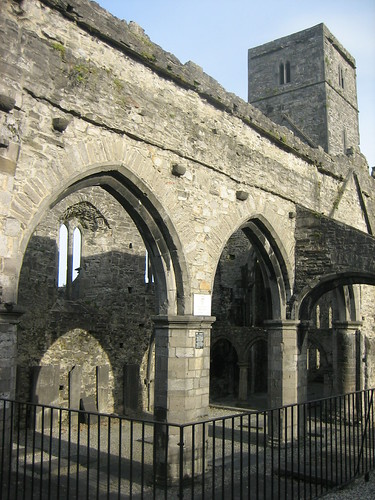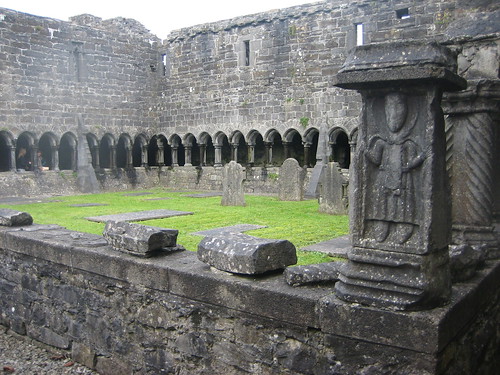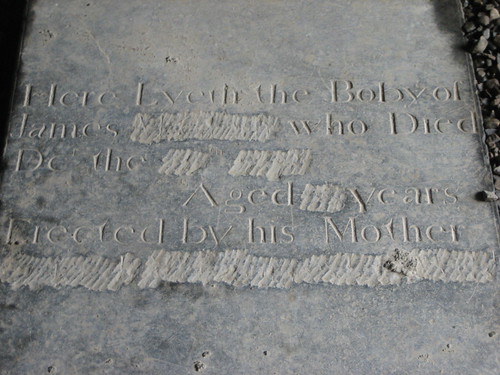(Now back to your regularly-scheduled blog entry.)
 Brendan and I spent the weekend in Sligo, where I did a bit of research for the second edition of Moon Ireland. Most visitors come to pay homage to William Butler Yeats, who is buried in the graveyard at Drumcliff not far outside town, at the church where his great-grandfather was rector. We, on the other hand, came to socialize, shop for wooly goodness from County Donegal, climb up Knocknarea (pictures next post), and listen to Renaissance choral music in the ruins of Sligo Abbey. It was awesome. Here are some of my best shots from the abbey.
Brendan and I spent the weekend in Sligo, where I did a bit of research for the second edition of Moon Ireland. Most visitors come to pay homage to William Butler Yeats, who is buried in the graveyard at Drumcliff not far outside town, at the church where his great-grandfather was rector. We, on the other hand, came to socialize, shop for wooly goodness from County Donegal, climb up Knocknarea (pictures next post), and listen to Renaissance choral music in the ruins of Sligo Abbey. It was awesome. Here are some of my best shots from the abbey.

And here's a shot from the concert, which was actually part of a larger project by English filmmaker Sonia Boyce (you can see her with her camera on the bottom left of the photo below. Notice, too, how the choral director is standing on a grave slab.) A "sound artist" made shrieking and humming sounds to form a sort of "dialogue" with the choral singers. (You can't see him in this shot, but he was wearing jagged cardboard wings, a sort of white neck-dress, and a white robe. This element of the performance was somewhat pretentious, but I enjoyed it regardless.) The choral group is UK-based Alamire, and you can see a clip from the video installation here.

The abbey itself was a real treat too. The last time I visited Sligo was during the week in wintertime, so I wasn't able to visit it. The cloister and Gothic and Renaissance tombs are all remarkable, and I got a macabre history lesson from one of the guides behind the front desk. The buildings have a sunken appearance, he said, because of all the people buried in the surrounding graveyard during the cholera epidemic of 1832. Fearing ongoing contagion, church leaders closed the abbey graveyard and opened a new one a mile outside town; but this land was so sacred to the Catholics of Sligo that they would go back to the new cemetery late at night to exhume their relatives and rebury them here. It had to be done hastily and without the aid of a lantern, so that body parts were often seen protruding from the earth. All these shallow graves led to a rising of the earth around the abbey walls.
I had heard that Bram Stoker's work was influenced by the horrors of that epidemic. More from Sligo: A Short History:
People were left dead in the streets and whole families were wiped out. Bram Stoker (the author of Dracula) had his macabre imagination fired by his mother, a Sligo woman, who told stories of coffin makers knocking on doors in the night looking for corpses and of victims being buried alive.
The guide told me that the dying were often left unconscious in open graves. The people who left them there were, of course, afraid of contracting the disease themselves. He said there was zero chance that these victims could recover...but what if they should wake up before they died? Too horrible to contemplate.Here's another item of interest from the abbey floor:
 Why were James' family name and details effaced? It's possible he brought some sort of shame upon his family, or that his remains were reinterred elsewhere. Most interesting to me was the curious spelling of "body." According to the abbey brochure, the average stonecarver was illiterate.
Why were James' family name and details effaced? It's possible he brought some sort of shame upon his family, or that his remains were reinterred elsewhere. Most interesting to me was the curious spelling of "body." According to the abbey brochure, the average stonecarver was illiterate.

3 comments:
Ooh. It looks spooky and romantic.
Body parts, Bram Stoker, effaced grave markers... Your real life travels sound like an adventurous story, a captivating panegyric on the churches of Sligo.
Great post. I love Sligo, and you've high-lighted a really great part of the county.
Yeats is from Sligo? Now you tell me....
Post a Comment